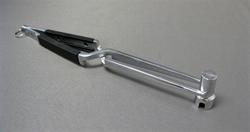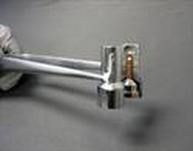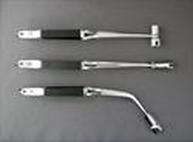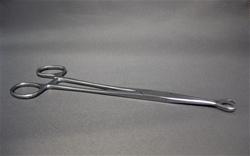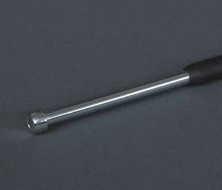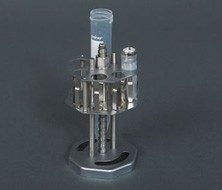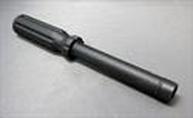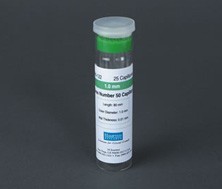Hampton蛋白结晶工具及仪器
CryoTong™ – Long
ApplicationsCrystal transfer under cryo temperature
FeaturesArtery clamp style closure30 seconds of cryo temperature180 mm length
Description
The CryoTong is a tool used to manually transfer a crystal mounted on a CrystalCap™ from liquid nitrogen to a magnetic base in a goniometer head positioned in a cryogenic stream, and then back to liquid nitrogen. The one-piece, compact CryoTong is available in two lengths. The long CryoTong is approximately 180 mm in overall length. The artery clamp style maintains the CryoTong in the closed position until the clamp is squeezed, which opens the opposing heads. The heads are non-magnetic stainless steel. The handle is magnetic stainless steel. The inside of the head is machined to closely surround the CrystalCap with loop and crystal in place. A small retaining lip is machined into the lower portion of the head to prevent the CrystalCap from slipping out of the CryoTong when the tool is in the closed position. The CryoTong can maintain the temperature of the crystal at -160°C for up to 30 seconds during room temperature crystal transfers. Choose the proper CryoTong size based upon the pin length required by the configuration of the x-ray data collection hardware used. The 18 mm CryoTong (HR5-112) is to be used with the CrystalCap HT and any other CrystalCap configured for 18 mm.HR5-114 Long CryoTong 18 mm, 180° features the head in alignment with the handle of the CryoTong.
ApplicationsVial support and manipulation
FeaturesStraight end tipHemostat style closureDescription
The Vial Clamp™ – Straight is a chrome plated, hemostat style tool. It has a tip shaped to hold the storage vial of all the CrystalCap Systems™ straight when the clamp is closed. The clamp can be locked using the hemostat style closure. This clamp makes it easy to dip the storage vial into liquid nitrogen for crystal storage. The complete length of the clamp is straight, with an overall length of 195 mm. When the vial is placed in the clamp, the length of it is positioned perpendicular, 90° to the length of the clamp.
ApplicationsCrystalCap Magnetic & CrystalCap Copper Magnetic handling toolDescription
The CrystalWand Magnetic is designed to be used exclusively with the CrystalCap Magnetic, CrystalCap Copper Magnetic, and CrystalCap HT systems during transfer of the caps from the vial to the goniometer head and from the goniometer to the vial. The 6 1/2” (165 mm) long chrome plated steel wand features a plastic housing enclosing a spring tensioned plunger that when depressed, moves a non-magnetic steel platform away from the magnet housed in the end of the wand. This causes the steel CrystalCap to detach from the wand and be placed readily into the vial or the CryoTong™. When the platform is retracted, the wand securely holds the steel CrystalCap Magnetic. The CrystalWand Magnetic 45° (McMiken Tool) offers the same functionality but is bent at a 45° angle at approximately 2.5 cm from the magnet end.HR4-729 CrystalWand Magnetic, StraightHR4-315 CrystalWand Magnetic, 45° (McMiken Tool)
ApplicationsVial support & manipulation
FeaturesCurved end tipHemostat style closureDescription
The Vial Clamp – Curved is a chrome plated, hemostat style tool. It has a tip shaped to hold the storage vial of all the CrystalCap Systems at an angle when the clamp is closed. The clamp can be locked using the hemostat style closure. The end of the clamp, where the vial is held, is curved at either a 45°/135° or 110°/ 70° angle. When the vial is placed in the clamp, the length of it is positioned to the clamp at either of those same angles. The overall length of each clamp is the same, 195 mm.HR4-671 Vial Clamp – Curved 45°/135°HR4-672 Vial Clamp – Curved 110°/70°
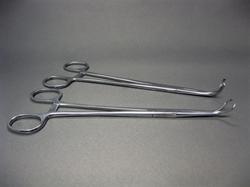
pplicationsCrystalCap support inside stainless steel dewars
FeaturesAdjustable heightSupports up to 8 CrystalCaps15 ml vial position for liquid propane500 and 1,000 ml versionsDescription
CrystalCap Holders are convenient stands for holding all CrystalCap™ systems in liquid nitrogen dewars during crystal cryogenic procedures. Available in two sizes. Both holders feature spring-clips to secure the CrystalCap Vials in the holder. Both stands have 3 inches of adjustable Z (height) which allows one to raise or lower the CrystalCaps to the appropriate height, depending upon the liquid nitrogen level in the dewar. Each holder is supplied with a socket driver for height adjustment.500 ml version holds five CrystalCaps, two 15 ml vials (for liquid propane procedures) and fits into the 500 ml dewar. 1,000 ml version holds eight CrystalCaps, two 15 ml vials (for liquid propane procedures) and fits into the 1,000 ml dewar.HR4-707 CrystalCap Holder – 500 ml
HR4-706 Replacement Height Adjustment Tool

